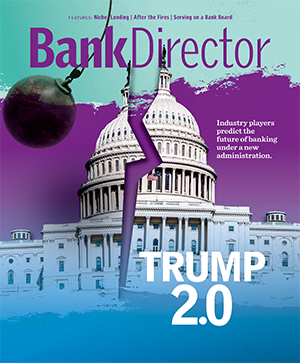
Corporate Governance Award: Salisbury Bancorp, Lakeville, Connecticut
And the winner is…Salisbury Bancorp
Until recently, the board of directors at Salisbury Bancorp in Lakeville, Connecticutu00e2u20ac”a rural hamlet tucked away in the Berkshire Mountainsu00e2u20ac”included two practicing attorneys, a retired managing director from Citigroup, a bookseller, an insurance agent, a gentleman farmer, and a veterinarian. And when the vet moved away, the president of a local water company took his place.
A diverse group, to be sure, and one that is quite representative of the boards at most small banks throughout the country. None of the directors are high-powered business executivesu00e2u20ac”just ordinary people with deep ties to the community. And yet over the past three years, Salisbury’s board, including President and Chief Executive Officer John F. Perotti, has presided over a successful acquisition and a doubling of the company’s stock price.
How did it do this? First, by facing the fact that Salisbury could either grow or dieu00e2u20ac”there was no in-between. Next, by working closely with Perotti to develop a strategic growth plan for the bank and then supporting, and sometimes challenging, him at every turn. It is, therefore, this same thoughtful, conscientious and pragmatic manner in which the board of directors has overseen Salisbury’s affairs that has earned it Bank Director magazine’s Board Governance Award for 2004.
The $425 million bank, which traces its heritage back to the founding of the Salisbury Savings Society in 1848, is located in the extreme northwest corner of Connecticut, just three miles east of the New York border and seven miles south of Massachusetts. It is an area with relatively little industry; tourism and small service businesses drive the local economy. The community includes lots of weekend refugees from New York City, or “212ers” as they’re called in those parts.
John R.H. Blum, a local farmer who once served as the state’s commissioner of agriculture, joined the board in 1995 and was elected chairman in 1998. He describes it as a small, diverse group of people that talk to each other. “Being small works for us in terms of maximizing communication between John [Perotti] and ourselves,” he says. “It’s just more focusedu00e2u20ac”which is a good thing if you have enough diversity. It [makes it] easier to work by consensus, which we’ve almost always done. I can’t remember the last split vote we had.”
But working by consensus doesn’t mean Salisbury’s directors have always seen things the same way, or are afraid to disagree with one another. One of the board’s biggest challenges occurred in the mid-1990s when Salisbury received an unsolicited offeru00e2u20ac”or so-called bear hugu00e2u20ac”from a larger bank. Blum says initially there was no clear consensus among board members as to how they should handle the situation. Some directors wanted to turn the suitor down flat. Others wanted to explore a possible sale in the interest of Salisbury’s shareholders. Eventually, the board agreed to meet with the suitor and, according to Blum, did a considerable amount of due diligence on the proposed deal. It met several times with the suitor’s management team before concluding that a takeover by this particular organization would have eviscerated the bank. “That would have been a slash-and-burn proposition,” Blum says. The board gradually achieved a consensus not to do the deal. “We worked through it by working through it,” he adds.
But if Salisbury wanted to remain independent, it had to earn that right. And the biggest challenge facing the bank’s directors and its management team was the dearth of growth opportunities in its service area. Perotti says the lack of an industrial base has made it difficult to make higher margin commercial loans, so the bank has focused on less-profitable mortgage and consumer loans instead. “I think the biggest challenge we faced was remaining profitable.”
Perotti and the board still believed there was a future for well managed community banks, but to survive, they would have to adopt more of a shareholder focus. “We needed to improve on each quarter’s earnings to enhance shareholder value and move the stock price,” he says. And to do that, Salisbury would have to find some way to expand. “We had a consensus that we couldn’t remain a community bank without strategic growth,” adds Blum.
And as that epiphany sunk in, two things happened at Salisbury. One, the board took a more active role in strategic planning as it considered various options, including doing an acquisition of its own. And it also put more pressure on Perotti to improve the financial performance of the bank. “They were very, very strict in the budgeting process,” Perotti says. Sometimes he says, “they would kick a proposed budget back and say, ‘The bar isn’t high enoughu00e2u20ac”you have to stretch,’ ” he recalls. “The board held management’s heels to the fire.”
Salisbury bought a branch in Bridgeport, Connecticut from another institution in 2000, which expanded it into an area with greater business loan opportunities. For several years Salisbury also had kept an informal merger discussion going with the management at Canaan National Bancorp, a $100 million bank in a nearby community. Finally, in the fall of 2002, Canaan agreed to be acquired by Salisbury if it could work out certain issues. “It fit in with the goal of being more sharply strategic,” says Blum.
But it took more than a year to close the $15.5 million deal because Canaan’s board wanted the bank’s entire staff to have jobs at Salisbury after the merger. It took Perotti and his board more time to work out a business plan that would accomplish that objective while also providing their shareholders with a good return on the deal. In the end, most of Canaan’s employees did join Salisbury.
One potential problem was averted from the get-go: Canaan’s former CEO, Gerald Baldwin, did not want to be CEO of the new bank. However, he did want a seat on the board, but this bucked a tradition at Salisbury where the CEO was the only inside director. “With an organization this small, we don’t need more than one insider on the board,” Perotti explains. There also was pressure on Salisbury to absorb all of Canaan’s directors, but Perotti and his directors didn’t want to enlarge their board to that degree. “I was dead set against expanding the board by 10,” he says. “I thought it was too many.” In the end, Salisbury invited two of Canaan’s outside directors to join its board. And a third Canaan director was asked to replace a longtime Salisbury board member when that person retired earlier this year.
Perotti believes the Canaan acquisition will help Salisbury achieve its strategic goal of becoming more consistently profitable. He describes Canaan’s former CEO, who has joined Salisbury as an executive vice president, as an “educated and experienced” commercial lender whose experience and personal contacts will help the bank grow. “I expect commercial lending to be a significant driver of profitability in the future,” he says.
One reason why Perotti and Salisbury’s independent directors were so reluctant to drastically alter the chemistry of the bank’s board is because it seemed to work so well. One strength that continues today is that it stays focused on the big picture, according to Blum. The board uses a consent agenda process, whereby a week prior to each regularly scheduled meeting, its directors receive a large packet of information covering many of the matters that routinely come before them. This allows the directors to spend their meeting time dealing with more substantive issues like strategy, Blum says.
The board’s independent directors also meet in executive session after every regularly scheduled meeting so they can talk candidly among themselves. Michael A. Varet, Salisbury’s largest shareholder and a director since 1997, says Perotti works well with a strong board where he’s the only insider. “We have a president who’s comfortable with that,” says Varet. “He’s not threatened. I think he thinks we actually help him. Sometimes we encourage him; sometimes we discourage him. But it’s always done with a sense of fairness.”
An attorney who works for a Manhattan law firm, Varet and members of his family have been coming to the Berkshires for years. He is one of those 212ers, but still has a deep regard for the communities Salisbury serves. He says the bank’s other directors all feel the same way. None of them own large blocks of Salisbury stock, but see their fiduciary role as a kind of public service. “It’s not a bunch of cronies who control the bank and control the board and do what they please,” he says. One important factor is the nature of the communities Salisbury serves. “It’s a small town,” Varet says of Lakeville. “To a large extent, people know everybody. There are a lot of shareholders in town. [Serving on the board] is not anonymous. It’s not like sitting on the board of Citigroup.”
Varet believes that ordinary people like he and his fellow directors can provide effective corporate governance. “Everyone on the board is smart and conscientious,” he says. “It’s not clear to me that any particular background is the best background for serving on the board of a community bank.”

Join OUr Community
Bank Director’s annual Bank Services Membership Program combines Bank Director’s extensive online library of director training materials, conferences, our quarterly publication, and access to FinXTech Connect.
Become a Member
Our commitment to those leaders who believe a strong board makes a strong bank never wavers.

